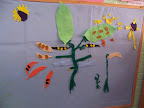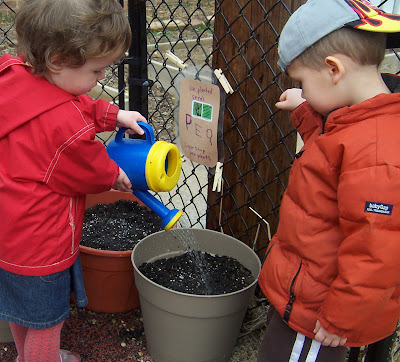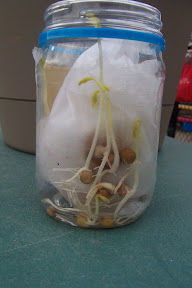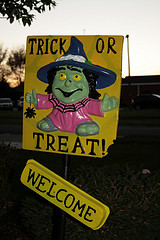
A sprouting bean plant constructed on a felt board.
Teacher of two-year-olds Sue Hewitt reports that she has already planted with one group—“lettuce last week and will do radish planting this week. I like to do something that can mature and be harvested and eaten by the kids. We usually have a salad bar one day—pick and wash and spin lettuce and have kids each bring in one thing to be in the salad. Then set up a row like a real salad bar and they choose. Of course the croutons are often the most popular!” I think the children could make croutons with whole wheat bread and herbed olive oil.

Some of my students have planted sugar snap peas. The package says they will be ready to harvest in 62 days! While we wait we can sing a song by
David Mallet,
Inch by Inch, Row by Row. You can learn it from
his children’s book of the same name, from a video his
website, or from Pete Seegar.
See
Pete Seegar’s rendition on YouTube to learn it, a good choice for young children too because the arrangement is simple–single performer, single instrument (banjo) and the audience participates.
Garden Song by David Mallett
CHORUS:
Inch by inch, row by row
Gonna make this garden grow
All it takes is a rake and hoe
And a piece of fertile ground.
Inch by inch, row by row
Someone bless these seeds I sow
Someone warm them from below
‘Till the rains come tumbling down.
(In the folksong tradition, another singer has added this verse.)
Inch by inch, row by row
Gonna make this garden grow
Gonna mulch it deep and low
Gonna make it fertile ground
Pullin’ weeds and pickin’ stones
We are made of dreams and bones
Feel the need to grow my own
‘Cause the time is close at hand.
Grain for grain, sun and rain
Find my way in nature’s chain
Tune my body and my brain
To the music from the land.
CHORUS
Plant your rows straight and long
Temper them with prayer and song
Mother Earth will make you strong
If you give her loving care

CHORUS
Old crow watching hungrily
From a perch in yonder a tree
In my garden I’m as free
As that feathered thief up there
CHORUS
© Cherry Lane Music Co (ASCAP)
To closely observe pea seed sprouting, “plant” them in a clear container, right next to the wall of the container with damp paper towels inside. You can see that these sprouts have not been near a window—see how pale green they are!
—Peggy



 I wonder how teachers include the “E” in this acronym when designing or selecting class activities. And yet, the play that children do can be the foundation for future interest in engineering. This issue has several articles that describe how to capitalize on children’s curiosity and problem-solving abilities with engaging and purposeful activities, from race cars (
I wonder how teachers include the “E” in this acronym when designing or selecting class activities. And yet, the play that children do can be the foundation for future interest in engineering. This issue has several articles that describe how to capitalize on children’s curiosity and problem-solving abilities with engaging and purposeful activities, from race cars (

 My next-door neighbor is a lovely young woman, currently at the top of her junior class and gathering information on colleges. She’s interested in studying chemistry/chemical engineering (hooray!). I was reflecting on the opportunities she has that did not exist years ago when I was in her situation. Many colleges with strong science/engineering programs were men-only then or they did not encourage women to apply to these majors. We’ve come a long way, but we’re still talking about science-for-all issues.
My next-door neighbor is a lovely young woman, currently at the top of her junior class and gathering information on colleges. She’s interested in studying chemistry/chemical engineering (hooray!). I was reflecting on the opportunities she has that did not exist years ago when I was in her situation. Many colleges with strong science/engineering programs were men-only then or they did not encourage women to apply to these majors. We’ve come a long way, but we’re still talking about science-for-all issues. The conference blog has reported on some interesting topics/conference events and sights to see in Philadelphia, but you’re disappointed that you won’t be able to attend this year—the economy, schedule conflicts, time constraints, etc. So here’s an offer you can’t refuse. I’m a “free agent” at the conference. Other than a few must-see general sessions, my schedule is open. So let me know via a comment if there is a hot topic in your school, with a brief context as to why it’s “hot.” I’ll be your avatar and attend some sessions on the topic. I’ll report back via the MsMentor blog after the conference.
The conference blog has reported on some interesting topics/conference events and sights to see in Philadelphia, but you’re disappointed that you won’t be able to attend this year—the economy, schedule conflicts, time constraints, etc. So here’s an offer you can’t refuse. I’m a “free agent” at the conference. Other than a few must-see general sessions, my schedule is open. So let me know via a comment if there is a hot topic in your school, with a brief context as to why it’s “hot.” I’ll be your avatar and attend some sessions on the topic. I’ll report back via the MsMentor blog after the conference.